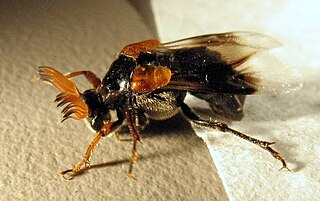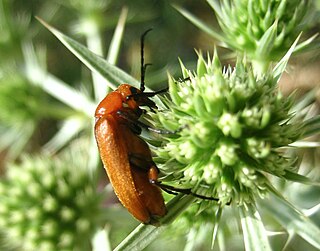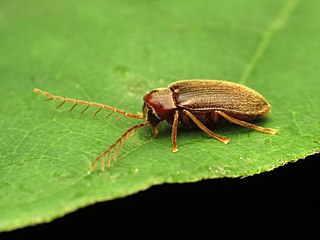Related Research Articles

Pentatomidae is a family of insects belonging to the order Hemiptera, generally called shield bugs or stink bugs. Pentatomidae is the largest family in the superfamily Pentatomoidea, and contains around 900 genera and over 4700 species. As hemipterans, the pentatomids have piercing sucking mouthparts, and most are phytophagous, including several species which are severe pests on agricultural crops. However, some species, particularly in the subfamily Asopinae, are predatory and may be considered beneficial.

Ripiphoridae is a cosmopolitan family of some 450 described species of beetles sometimes called "wedge-shaped beetles". Ripiphoridae are unusual among beetle families in that many species are hypermetamorphic parasitoids, an attribute that they share with the Meloidae. Members of the family differ in their choice of hosts, but most attack various species of bees or wasps, while some others attack cockroaches or beetles. Many species of Ripiphoridae have abbreviated elytra, and flabellate or pectinate antennae.

Cantharis is a large genus of soldier beetles in the family Cantharidae with narrow and soft elytra.

Melyridae are a family of beetles of the superfamily Cleroidea.

Centuria Insectorum is a 1763 taxonomic work by Carl Linnaeus, and defended as a thesis by Boas Johansson; which of the two men should for taxonomic purposes be credited with its authorship has been the subject of some controversy. It includes descriptions of 102 new insect and crustacean species that had been sent to Linnaeus from British America, Suriname, Java and other locations. Most of the new names included in Centuria Insectorum are still in use, although a few have been sunk into synonymy, and one was the result of a hoax: a common brimstone butterfly with spots painted on was described as the new "species" Papilio ecclipsis.

Phyllobius glaucus is a species of weevil found across Europe, especially in carrs. It is a pest of a variety of fruit trees, but has little economic effect. It was first described by Giovanni Antonio Scopoli in 1763.

Lampetis is a genus of beetles in the family Buprestidae, containing the following species:

Mylabris is a genus of beetles in the family Meloidae. It is endemic to the Palearctic realm. The species-rich genus Hycleus was historically confused with Mylabris and have their greatest diversity in the Afrotropics.

Atractocerus is a genus of beetles in the family Lymexylidae. The most recent revision of the family treats several small or monotypic genera as synonyms of Atractocerus, though some authors continue to use the older generic names (e.g.).

Zonitis is a genus of blister beetles in the family Meloidae. The genus was named and described by Johan Christian Fabricius in 1775.

Ptilodactylidae is a family of beetles belonging to the Elateriformia. There around 500 extant species in 35 genera. They are generally associated with riparian and aquatic habitats. The larvae generally live associated with rotting wood or vegetation, or within gravel and detritus on the edge of water bodies. The larvae of some species feed on submerged rotting wood or on plant roots, while the adults of some species are known to feed on fungus with modified brush-like maxillae.

Pseudocolaspis is a genus of leaf beetles in the subfamily Eumolpinae. It contains about 80 species, which are found in tropical Africa.

Neomida is a genus of darkling beetles in the family Tenebrionidae. There are about 18 described species in Neomida.

Diaperis is a genus of darkling beetle with species known from Asia, Europe, and the Americas. Some species were formerly placed in the genus Allophasia. A species described in this genus is now Serrania viridula.

Aphanus is a genus of dirt-colored seed bugs in the family Rhyparochromidae. There are more than 20 described species in Aphanus.
References
- ↑ E. G. Linsley, J. W. MacSwain & C. D. Michener (1980). Nesting Biology and Associated of Melitoma (Hymenoptera, Anthophoridae). University of California Publications in Entomology, Volume 90. University of California Press. ISBN 0-520-09618-5.
- ↑ M. García-París, D. Buckley & G. Parra-Olea (2007). "Catálogo taxonómico-geográfico de los coleópteros de la familia Meloidae de México" (PDF). Graellsia . 63 (2): 165–258. doi: 10.3989/graellsia.2007.v63.i2.92 . hdl: 10261/23551 .